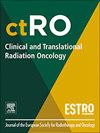低氧条件对大鼠前列腺癌质子照射后局部肿瘤控制的影响
IF 2.7
3区 医学
Q3 ONCOLOGY
引用次数: 0
摘要
背景和目的肿瘤缺氧与放射抵抗有显著关系,往往导致治疗效果差。体外研究表明,质子辐照不仅具有较高的相对生物有效性(RBE),而且具有较低的氧增强比(OER)。本研究探讨了低氧和缺氧条件对大鼠前列腺癌质子照射后局部肿瘤控制的影响。材料与方法用不同剂量的单次质子在缺氧或缺氧条件下照射皮下移植的Dunning R3327-HI大鼠前列腺癌。通过夹紧肿瘤供血血管诱导缺氧。生物学终点是照射后300天评估的局部肿瘤控制。确定剂量-反应曲线,并根据50%肿瘤控制概率(TCD50)所需剂量计算RBE和OER。结果低氧条件下TCD50值明显高于缺氧条件下(73.4±1.9 Gy vs. 50.5±1.6 Gy),质子辐照OER为1.45±0.06。与光子辐照相比,在缺氧条件下,质子的RBE为1.23±0.07,在缺氧条件下为1.30±0.04。结论质子照射可使OER比先前测量的光子值(1.53±0.08)降低5%,表明质子治疗缺氧肿瘤的有效性略高于光子治疗。本文章由计算机程序翻译,如有差异,请以英文原文为准。
Impact of hypoxic versus oxic conditions on local tumor control after proton irradiation in a rat prostate carcinoma
Background and purpose
Hypoxia in tumors significantly contributes to radiation resistance, often leading to poor treatment outcomes. In vitro studies demonstrated that proton irradiation not only exhibits an increased relative biological effectiveness (RBE), but also a lower oxygen enhancement ratio (OER). This study explored the impact of hypoxic and oxic conditions on local tumor control after proton irradiation in a rat prostate carcinoma.
Material and methods
Subcutaneously transplanted Dunning R3327-HI rat prostate carcinomas were irradiated with varying single doses of protons under oxic or hypoxic conditions. Hypoxia was induced by clamping the tumor-supplying vessels. The biological endpoint was local tumor control assessed 300 days after irradiation. Dose-response curves were determined and based on the doses required for 50 % tumor control probability (TCD50), the RBE and OER were calculated.
Results
The TCD50 value was significantly higher under hypoxic than under oxic conditions (73.4 ± 1.9 Gy vs. 50.5 ± 1.6 Gy), resulting in an OER of 1.45 ± 0.06 for proton irradiation. Compared to photon irradiation, the RBE for protons was of 1.23 ± 0.07 under oxic and 1.30 ± 0.04 under hypoxic conditions.
Conclusion
Proton irradiations showed a 5 % reduction in OER compared to the previously measured photon value of 1.53 ± 0.08, suggesting a slightly higher effectiveness of protons in hypoxic tumors as compared to photons.
求助全文
通过发布文献求助,成功后即可免费获取论文全文。
去求助
来源期刊

Clinical and Translational Radiation Oncology
Medicine-Radiology, Nuclear Medicine and Imaging
CiteScore
5.30
自引率
3.20%
发文量
114
审稿时长
40 days
 求助内容:
求助内容: 应助结果提醒方式:
应助结果提醒方式:


